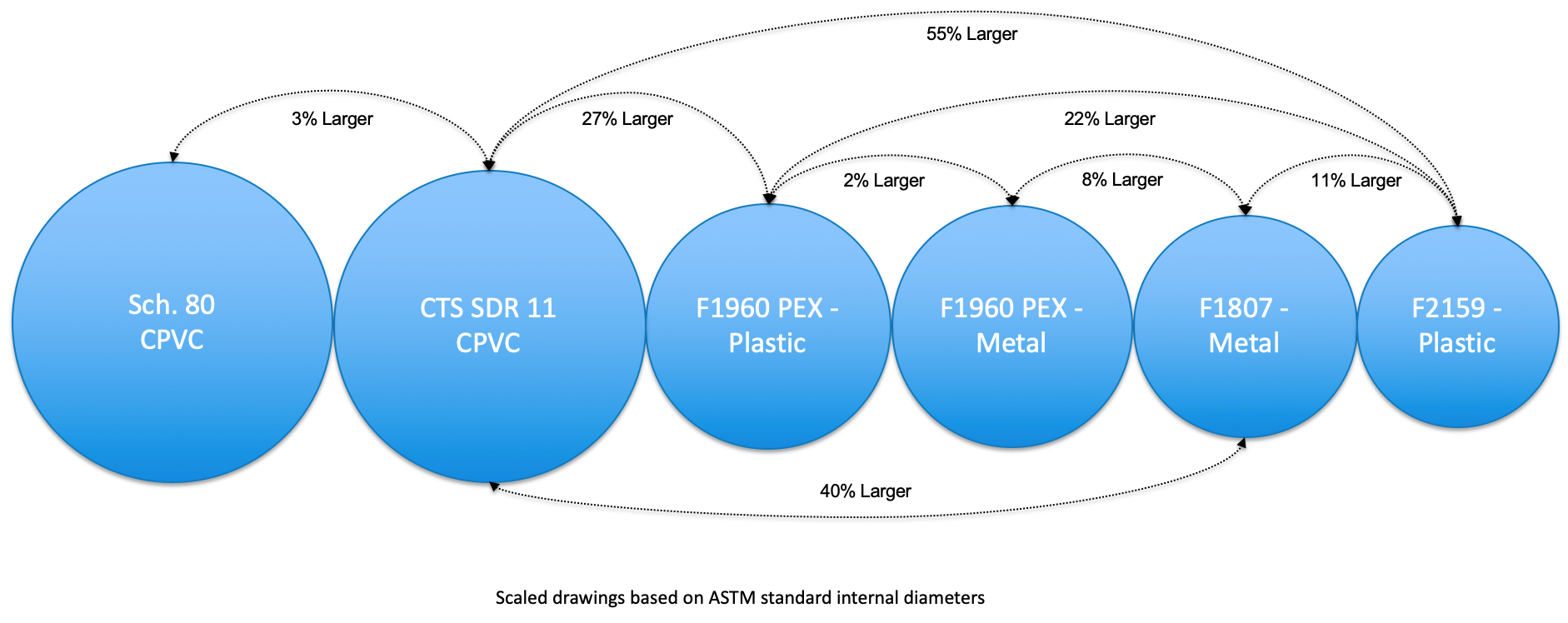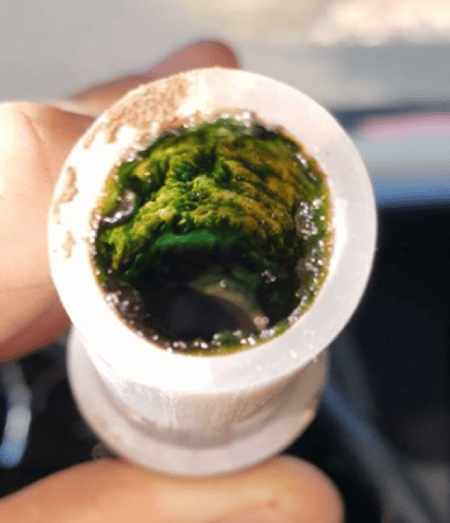Product Comparison
PEX and CPVC are plastic piping systems used in residential plumbing. But the similarities end there. So which material is best for your application?
The two materials have significant differences in their chemistry, construction and performance. Understanding these differences can help you deliver better reliability and water quality to your customers while protecting the reputation of your business.
| FlowGuard Gold®CPVC | PEX | |
|---|---|---|
| Chlorine Resistance | Inherently resistant | Subject to degradation under certain conditions |
| Flow Rates | Full flow through fittings | Restricted flow through fittings |
| Leaching | NSF 61 compliant under all conditions | Dependent on water conditions for some brands |
| Biofilm Growth Potential | Lower growth potential | Higher growth potential |
| UV Exposure | Does not impact service life of pipe | Accelerates effects of chlorine degradation |
| Warranty | Applies regardless of water treatment methods | Voided by some water conditions |
| Cost | Lower cost | Higher cost |
| Installation | Easy installation | Easy installation |
CPVC Has More Chlorine Resistance Than PEX
PEX, like polybutylene, is a European technology that is not inherently resistant to water treatment chemicals used in the U.S. The chief culprit is chlorine and its variants such as chloramine and chlorine dioxide. While PEX manufacturers have repeatedly attempted to re-invent the material to limit product liability claims, PEX remains susceptible to chlorine degradation in certain conditions.
This is evident in PEX ratings. While PEX tubing may carry a temperature and pressure rating of 100psi at 180°F, the pipe is not listed to perform under those conditions in the presence of chlorinated water. The use of chlorine-based disinfectants reduces the temperature rating of PEX by 40°F (from 180°F to 140°F.).
Operating outside those ratings can result in reduced service life as noted in a 2018 technical note from the Plastic Pipe Institute (PPI). The technical report highlights that pressures over 80psi, temperatures over 140F and/or aggressive water quality can significantly reduce the service life of a PEX pipe.

In the presence of hot chlorinated water, PEX has experienced pinhole leaks and pipe failures that led to the need for a complete re-pipe less than 10 years after installation. FlowGuard Gold CPVC is naturally immune to chlorine due to the inclusion of chlorine in its molecular structure and the materials ratings are not affected by the presence of chlorine. FlowGuard Gold pipes and fittings have also proven reliable under U.S. water conditions for more than 60 years. CPVC is even recommended for handling concentrated chlorine disinfectants at water treatment facilities.
As water distribution systems continue to expand to serve growing suburbs and exurbs, water treatment facilities are turning to more powerful chlorine based disinfects, making chlorine resistance more important than ever. With FlowGuard Gold CPVC, homeowners, builders and plumbing contractors all have the peace of mind that comes with CPVC’s inherent immunity to chlorine.
CPVC Pipes Offer Better Water Pressure Than PEX
CPVC uses fittings similar to copper in which the pipe is inserted into the fitting. With PEX, the pipe fits around the outside of the fitting so the internal diameter of the pipe is reduced at each fitting—even when “full flow” expansion fittings are used.

Depending on the fitting used, this can reduce the internal diameter of a ½” pipe by 21% to 35%. At a rate of 8 feet per second, PEX fittings create a 23% to 54% reduction in flow. For every ½” fitting, a PEX fitting can introduce 2 to 3 psi of pressure drop/fitting. In comparison, FlowGuard Gold fittings at the same size introduce 0.3 psi of pressure drop. This results in PEX systems frequently being upsized, often resulting in increased costs and wasted water.
FlowGuard Gold pipes and fittings are full flow and will not cause significant pressure drop.
CPVC is More Effective at Maintaining Water Quality than PEX
Three factors affect a plumbing material’s ability to maintain water quality:
- Biofilm Growth Potential: Biofilms, including Legionella and other harmful bacteria, can grow inside residential water pipes. Third party studies show that CPVC piping, such as FlowGuard Gold pipes and fittings, consistently demonstrate a lower risk of biofilm formation than PEX.

- Leaching: PEX piping is known to leach regulated substances, including gasoline components such as MTBE, ETBE, TBA and Toluene, into drinking water, in excess of some state regulated levels. The industry standard for preventing unsafe health impacts from plumbing systems due to chemical leaching is NSF 61. While some PEX products are not certified to NSF 61 at elevated temperatures, FlowGuard Gold CPVC is certified to NSF 61 under all water conditions and fully complies with all state drinking water regulations.
- Permeability: PEX is a permeable material, meaning that contaminants coming in contact with the outside of the pipe may be transmitted through the pipe wall leading to water contamination. The U.S. EPA, in their study on Permeation and Leaching, has found that vinyls are virtually impermeable at low levels of exposure and at high levels of exposure would actually fail before allowing the water to become contaminated. This means vinyl-based pipes and fittings, such as CPVC, effectively mitigates the risk of water contamination through chemical permeation.
To help determine the impact of piping materials on water quality, scientists at Virginia Tech studied the impact of a variety of piping materials, including copper, HDPE, PEX and CPVC. The study found "the short-term ability of all pipe materials, except CPVC, to impact water quality and aesthetics." The study noted that "CPVC was the most inert of the materials tested and had the least impact on water quality." While no plumbing system can actually improve water quality, FlowGuard Gold CPVC is more effective than PEX at maintaining water quality.
CPVC Has Better UV Resistance
Ultraviolet rays can come from the sun or fluorescent lightbulbs. They have an aging effect on many surfaces ranging from human skin to plastic pipes. However, the impact of UV aging varies dramatically between FlowGuard Gold CPVC and PEX.
UV light consumes the antioxidants used in PEX to protect against chlorine degradation. In some cases, just 1 month of exposure to UV rays can reduce the time-to-failure of PEX by up to 21%.
While UV exposure may cause discoloration or reduced impact resistance in FlowGuard Gold pipes and fittings, the pressure-bearing capability and life-expectancy under normal use conditions is unaffected.
The CPVC Warranty Allows for Water Treatment Methods
The Insurance Institute for Business & Home Safety reports that 65% of all plumbing system failure claims are due to material failure, not freezing or installation-related issues. These failures are often a result of chlorine degradation or other aggressive water conditions and can occur with PEX well within the material warranty period.
Unfortunately, for most PEX plumbing systems, the warranty can be voided by the water the pipe was intended to carry. That’s because PEX warranties typically contain “exclusions” for damage to the system caused by water conditions. So, if a PEX pipe fails due to corrosion or degradation caused by the water flowing through it, the warranty will not cover any damages or repairs.
FlowGuard Gold CPVC is the only plumbing system on the market today that offers a 30-year warranty on qualifying installations that specifically applies regardless of the water treatment methods.1
Cost and Installation
In addition to its superior chlorine resistance and ability to maintain high flow rates and water quality, FlowGuard Gold CPVC represents the money-saving choice in terms of both material and installation costs.
When a leading PEX manufacturer published a comparison of FlowGuard Gold CPVC and PEX material costs for a four-story building, we were surprised to see that, by their own calculations, FlowGuard Gold CPVC could save the contractor more than 50% compared to its own PEX product.
In addition, third-party research has found that CPVC installs about 15% faster than PEX in its most common configuration. PEX also requires expensive expansion or crimping tools and PEX fittings, including the body and crimp rings, which typically cost several times more than comparable CPVC fittings and take 2-3 times longer to properly assemble. Not only are PEX fittings more expensive, but even when properly assembled, they can result in joints that have been the subject of several high-profile failures.
For contractors working on a typical single-family home, using FlowGuard Gold CPVC can save from 38%-41% per project. Over the course of a year, that translates into tens of thousands of dollars of additional profits, depending on volume.
Appearance
Builders and contractors should be confident and proud of the appearance and performance of every product they use. FlowGuard Gold pipes and fittings provide a straight, professional appearance, eliminating disorganized runs that make the installation look unprofessional and use more materials per home.
With better reliability and water quality, lower costs, and higher flow rates, FlowGuard Gold CPVC is the right choice for every residential plumbing project.
| FlowGuard Gold CPVC | PEX | |
|---|---|---|
| Superior Water Quality | Yes | No |
| 60-year Service History | Yes | No |
| Maximum Chlorine Resistance | Yes | No |
| UV Resistance | Yes | No |
| Easy, Cost-Saving Instructions | Yes | No |
| Professional Appearance | Yes | No |
1. Qualifying installations are installed by contractors authorized by Lubrizol to issue FlowGuard Gold warranties. All information is accurate at the time of posting (January 2021)



